For decades, Rwanda has battled significant levels of hepatitis B (HBV) and C (HCV) infections. Sidonie Uwimpuhwe, Rwanda’s Country Director at the Clinton Health Access Initiative (CHAI) reports that an estimated 4% of the population were with living with HCV, whilst HBV prevalence was around 2% when the programme started. The burden is more pronounced in those over the age of 55, where HCV prevalence rises to 16%.1 The scale of infection is also slightly higher in vulnerable populations, such as those living with other conditions like HIV. Since HIV, HBV and HCV share transmission routes, prevalence of coinfections with HIV continues to be an issue. In 2017, a study found that the prevalence of HBV and HCV antibodies in people living with HIV were 4.3% and 4.6% respectively. Although antibody testing cannot confirm a chronic HBV or HCV infection, the study highlighted that these figures acted as a good proxy for chronicity.2
The 1994 genocide, saw health facilities and workforce severely impacted.3 The genocide claimed over a million lives and is thought to have led to widespread hepatitis transmission due to mass casualties.2 Thousands were also raped and exposed to HIV or HCV.4 Alongside exposure to contaminated blood during this period, unsafe needle use, dental care and past traditional practices led to higher transmission rates within the population. This contributes to today’s high caseload of hepatitis, especially in older people.
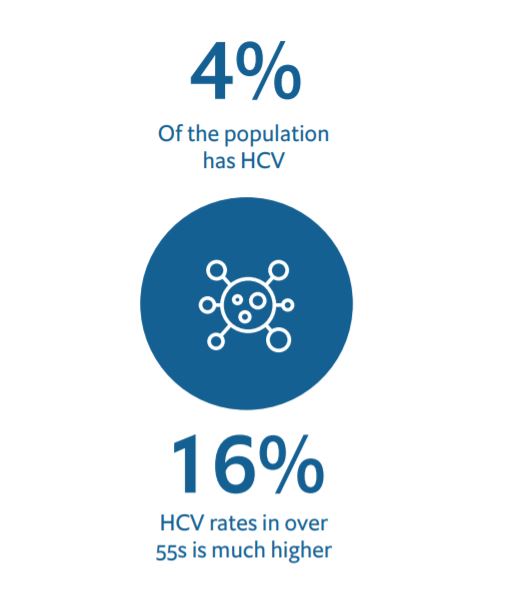
There is little difference in rates of HCV infection between urban and rural areas. Rates of HBV, however, are higher in the rural communities, with transmission from motherto-child, between household members and families being the main drivers.4 Prior to the introduction of direct-acting antivirals (DAAs) in 2014, people with HCV were treated with a series of interferon injections, which were expensive, ineffective (only about 40% of patients responded) and had major side effects.5
Building back the health system
The country was forced to build back its health system after its civil war and created ambitious plans to restore health services. Vision 2020 is a government development framework launched in 2000, with the objectives of reducing poverty, health problems and uniting the nation.6 Leadership at national and local levels was maintained during partnerships with non-governmental organisations to ensure that foreign aid was used in line with national strategies.7, 8
Facing a workforce crisis, emphasis was placed on increasing the numbers of health professionals by training physicians and nurses.9 A performance-based financing system was launched in 2005 to reward community health centres and district hospitals for better patient follow-up and primary care indicators, thus improving existing services.9
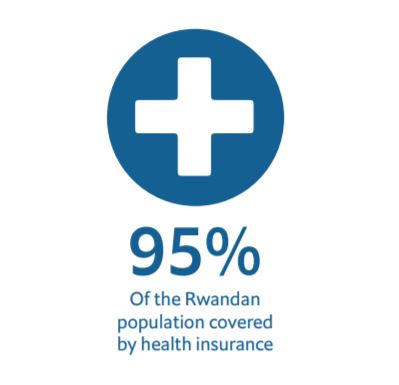
Ensuring that the population could access healthcare was recognised as a key mechanism to reduce poverty. A national mutual health insurance scheme, mutuelles de santé, was piloted in 1999.9 The most vulnerable citizens were enrolled into national social protection programmes and fully subsidised communitybased health insurance schemes (CBHI). In 2012, over 90% of the population was covered by insurance, that figure is now at 95%, and costs zero to a few dollars per year for individuals.10, 11
Keeping up the momentum: hepatitis prevention, testing and treatment
Using the momentum from the post-genocide health system rebuilding, Rwanda increased its activities towards tackling its hepatitis epidemic. In 1999, Rwanda introduced screening for HCV in recognition of its largely asymptomatic nature.12 The hepatitis B vaccine was introduced into the country’s expanded programme of immunisation (EPI) in 2000 in recognition of growing prevalence.13 Dr Sabin Nsanzimana, Director General of the Rwanda Biomedical Centre, adds that a birth-dose HBV immunisation programme is due to be introduced in 2021.
As part of prevention efforts, the Ministry of Health has introduced annual mass-media campaigns to raise awareness of hepatitis and mass screening in the general population and
“Rwanda’s viral hepatitis interventions are not part of a standalone programme. Everything is being built on top of existing infrastructure within the health system.”
Dr Sabin Nsanzimana
reduce stigma. The campaigns are delivered through community health workers, media outlets such as radio and television, and churches.14 The Ministry of Health also ensures that health practitioners are provided with training and education about risk reduction for exposure to hepatitis, infection control measures and implementation of the national clinical guidelines.15
To quantify the burden of hepatitis, robust screening and testing programmes are required. In 2013 Rwanda scaled up capacity for HCV testing by using existing HIV programmes, testing platforms and laboratory systems. All hospitals were provided with WHO-prequalified rapid diagnostic tests for HCV-antibody detection.16 National guidelines recommend that all adults are tested at least once, with annual testing for anyone with potential exposure to HCV infection. High risk groups are also recommended to undergo annual testing and pregnant women are advised to receive systematic testing. Screening and testing for HCV is currently available in multiple settings within hospitals, including antenatal care appointments, outpatient departments and blood transfusion centres.17
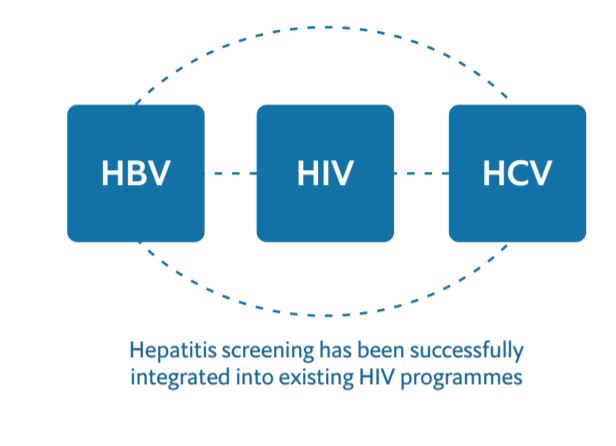
The reduction of financial and geographical barriers promotes access to health services and contributes to the success of any plan or programme. The Rwandan government has consistently negotiated price reductions for rapid diagnostic tests and treatments; it has also prioritised the inclusion of HCV screening, diagnosis and treatment under both public and private health insurance schemes.18 Dr Emmanuel Musabeyezu, a key player in the establishment of the hepatitis programme in Rwanda and a specialist in hepatitis management, highlighted the importance of coverage of hepatitis care under the public system, with people more likely to use the services and get tested if they do not have to pay.
In the past, people living with HCV in Rwanda were only treated by a small number of specialists. However, Rwanda has adopted a public health approach and decentralised health services away from specialists to general practitioners at the district level as part of scaling-up services.19, 20 Dr Musabeyezu explained that enables screening, viral load testing and treatment in a location convenient to individuals. This move has improved accessibility for patients and extended services to geographically hard-to-reach populations that would otherwise go untreated.
Rwanda’s aggressive approach to combating viral hepatitis is paying off. By the end of 2018, approximately 700,000 people were screened for HCV and 10,000 were cured with treatment.
“When you feel you are achieving something, it makes you work harder.”
Dr Emmanuel Musabeyezu
A bold and holistic elimination plan
Rwanda is one of the few countries in subSaharan Africa that has managed to achieve most of the health-related Millennium Development Goals, including noteworthy accomplishments in maternal and child health, control of HIV, tuberculosis and malaria.22
In 2018 Rwanda set its sights on a new challenge, committing to eliminating hepatitis C by 2024. It was the first country in subSaharan Africa to propose a five-year HCV elimination plan that included initiatives such as raising community awareness, ensuring affordability of screening and treatment, and solidarity with international partners.23 If Rwanda achieves its goal, it will have done so six years ahead of the 2030 global target for elimination set by the World Health Organization.2
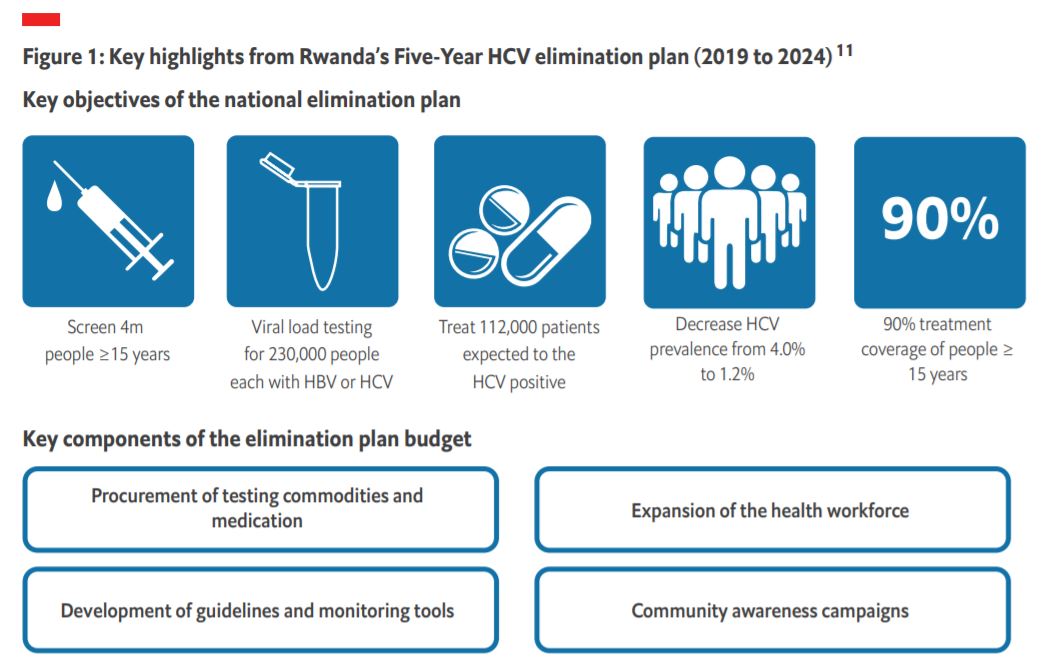
Spurred on by the elimination plan and building on the significant progress already made towards the goal, Rwanda started work on refining and scaling up its existing hepatitis services. Due to the substantial improvement in the affordability of screening tests, demand for screening has increased rapidly. The Rwandan Ministry of Health harnessed this opportunity to use the HCV screening programme to also screen people for HBV.24 This has been facilitated by the introduction of a new rapid diagnostic test that can be offered at the point of care, produces results in twenty minutes and costs just US$1, reduced from US$30.
The Rwandan government recognised that access to treatment plays a major role in the uptake of screening. It negotiated further reductions in treatment costs from US$80,000 to US$60. The reductions in medications costs were also a result of the fall in prices of generic medicines. The total estimated cost for the five-year plan was US$113m, but these dramatic savings mean the program cost is now predicted to be US$43m.25
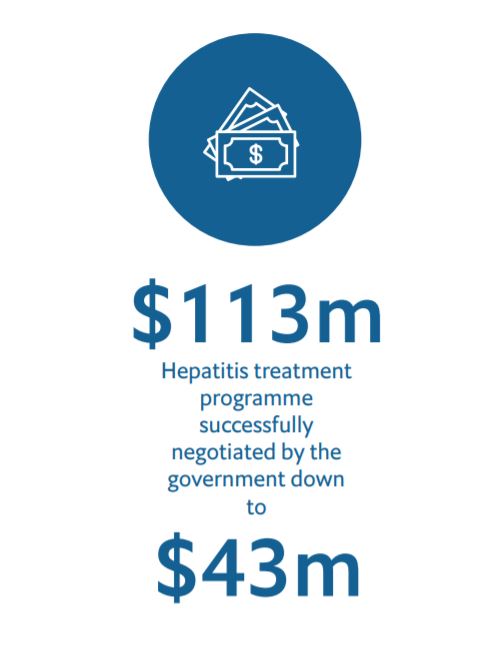
In addition to the geographical expansion of screening and testing sites to remote areas of the country, Rwanda is working towards training more physicians and nurses to be able to prescribe and monitor DAA treatment. Basing this initiative on a previous strategy for HIV control, the diagnosis and treatment of simple cases of HCV will be shifted from specialists to primary care doctors and nurses. Individuals with complications will still be referred to specialists.4
Final push to elimination: ensuring sustainability
Dr Musabeyezu highlights that Rwanda now faces the challenge of ensuring that the increasing number of people attending screening are linked to appropriate and high-quality care. At a system level, there is a need to ensure good supply management for medications to prevent or mitigate shortages. Programme monitoring and evaluation enables programmes to improve over time. To support this process, Ms Uwimpuhwe says CHAI is working with the Rwandan government to strengthen existing infrastructure, increase the skills of health workers through strong training and mentorship programs, as well as supportive e-learning tools and strong digital solutions to improve patient management and support.
Looking forward, Rwanda needs to continue working on improving accessibility to services in remote areas. Engaging with religious leaders, local government and the private sector will play a critical part in its success. Dr Nsanzimana adds that the government is exploring including hepatitis services in Rwanda’s CBHI.
Rwanda continues to pave the way towards viral hepatitis elimination and the learnings from its journey—characterised by sustained political commitment and investment, with innovative integration of services—will provide valuable insights for other countries in the region.
While every effort has been taken to verify the accuracy of this information, The Economist Intelligence Unit Ltd. cannot accept any responsibility or liability for reliance by any person on this report or any of the information, opinions or conclusions set out in this report. The findings and views expressed in the report do not necessarily reflect the views of the sponsor.
[1] Clinton Health Access Initiative. 2020. Partnerships Will Help Rwanda Eliminate Hepatitis C In Five Years - Clinton Health Access Initiative. [online] Available at: https://www.clintonhealthaccess.org/partnerships-will-help-rwanda-eliminate-hepatitis-c-in-five-years/
[2] Umutesi, J., Simmons, B., Makuza, J., Dushimiyimana, D., Mbituyumuremyi, A., Uwimana, J., Ford, N., Mills, E. and Nsanzimana, S., 2017. Prevalence of hepatitis B and C infection in persons living with HIV enrolled in care in Rwanda. BMC Infectious Diseases, [online] 17(1). Available at: https://
bmcinfectdis.biomedcentral.com/articles/10.1186/s12879-017-2422-9.
[3] Mbituyumuremyi, A., Van Nuil, J., Umuhire, J., Mugabo, J., Mwumvaneza, M., Makuza, J., Umutesi, J., Nsanzimana, S. and Gupta, N., 2017. Controlling hepatitis C in Rwanda: a framework for a national response. Bulletin of the World Health Organization, 96(1), pp.51-58.
[4] Donovan, P., 2002. Rape and HIV/AIDS in Rwanda. The Lancet, 360, pp.s17-s18.
[5] Ourworldunited.shorthandstories.com. 2020. Eliminating Hepatitis C In Rwanda. Available at: https://ourworldunited.shorthandstories.com/Eliminate_HepatitisC_Rwanda/index.html
[6] The Republic of Rwanda, 2012. Rwanda Vision 2020. [online] Kigali: The Republic of Rwanda. Available at: http://www.minecofin.gov.rw/fileadmin/templates/documents/NDPR/Vision_2020_.pdf
[7] Emery, N., 2013. Rwanda’s Historic Health Recovery: What The U.S. Might Learn. [online] The Atlantic. Available at: https://www.theatlantic.com/
health/archive/2013/02/rwandas-historic-health-recovery-what-the-us-might-learn/273226/
[8] Farmer, P., Nutt, C., Wagner, C., Sekabaraga, C., Nuthulaganti, T., Weigel, J., Farmer, D., Habinshuti, A., Mugeni, S., Karasi, J. and Drobac, P., 2013. Reduced premature mortality in Rwanda: lessons from success. BMJ, 346(jan18 1), pp.f65-f65.
[9] Mbituyumuremyi, A., Van Nuil, J., Umuhire, J., Mugabo, J., Mwumvaneza, M., Makuza, J., Umutesi, J., Nsanzimana, S. and Gupta, N., 2017. Controlling hepatitis C in Rwanda: a framework for a national response. Bulletin of the World Health Organization, 96(1), pp.51-58.
[10] Clinton Health Access Initiative. 2020. Partnerships Will Help Rwanda Eliminate Hepatitis C In Five Years - Clinton Health Access Initiative. [online]
Available at: https://www.clintonhealthaccess.org/partnerships-will-help-rwanda-eliminate-hepatitis-c-in-five-years/
[11] Makaka, A., Breen, S. and Binagwaho, A., 2012. Universal health coverage in Rwanda: a report of innovations to increase enrolment in communitybased health insurance. The Lancet, 380, p.S7.
[12] Umutesi, G., Shumbusho, F., Kateera, F., Serumondo, J., Kabahizi, J., Musabeyezu, E., Ngwije, A., Gupta, N. and Nsanzimana, S., 2019. Rwanda launches a
5-year national hepatitis C elimination plan: A landmark in sub-Saharan Africa. Journal of Hepatology, 70(6), pp.1043-1045.
[13] Muvunyi, C., Harelimana, J., Sebatunzi, O., Atmaprakash, A., Seruyange, E., Masaisa, F., Manzi, O., Nyundo, M. and Hategekimana, T., 2018. Hepatitis B
vaccination coverage among healthcare workers at a tertiary hospital in Rwanda. BMC Research Notes, 11(1).
[14] Mbituyumuremyi, A., Van Nuil, J., Umuhire, J., Mugabo, J., Mwumvaneza, M., Makuza, J., Umutesi, J., Nsanzimana, S. and Gupta, N., 2017. Controlling
hepatitis C in Rwanda: a framework for a national response. Bulletin of the World Health Organization, 96(1), pp.51-58.
[15] Ibid
[16] Umutesi, G., Shumbusho, F., Kateera, F., Serumondo, J., Kabahizi, J., Musabeyezu, E., Ngwije, A., Gupta, N. and Nsanzimana, S., 2019. Rwanda launches a
5-year national hepatitis C elimination plan: A landmark in sub-Saharan Africa. Journal of Hepatology, 70(6), pp.1043-1045.
[17] Mbituyumuremyi, A., Van Nuil, J., Umuhire, J., Mugabo, J., Mwumvaneza, M., Makuza, J., Umutesi, J., Nsanzimana, S. and Gupta, N., 2017. Controlling
hepatitis C in Rwanda: a framework for a national response. Bulletin of the World Health Organization, 96(1), pp.51-58.
[18] Ibid
[19] Ibid
[20] Clinton Health Access Initiative. 2020. Partnerships Will Help Rwanda Eliminate Hepatitis C In Five Years - Clinton Health Access Initiative. [online]
Available at: https://www.clintonhealthaccess.org/partnerships-will-help-rwanda-eliminate-hepatitis-c-in-five-years/
[21] Ibid
[22] Mbituyumuremyi, A., Van Nuil, J., Umuhire, J., Mugabo, J., Mwumvaneza, M., Makuza, J., Umutesi, J., Nsanzimana, S. and Gupta, N., 2017. Controlling
hepatitis C in Rwanda: a framework for a national response. Bulletin of the World Health Organization, 96(1), pp.51-58.
[23] Rwanda’s fight in the elimination of Hepatitis C Virus. Kigali: Ministry of Health; 2019. Available from: http://moh.gov.rw/index.php?id=19&tx_news_
pi1[news]=76&tx_news_pi1[day]=1&tx_news_pi1[month]=8&tx_news_pi1[year]=2019&cHash=5bd9a53465e639666f11d1b7aa0ea60a
[24] Clinton Health Access Initiative. 2020. Partnerships Will Help Rwanda Eliminate Hepatitis C In Five Years - Clinton Health Access Initiative. [online]
Available at: https://www.clintonhealthaccess.org/partnerships-will-help-rwanda-eliminate-hepatitis-c-in-five-years/
[25] Ourworldunited.shorthandstories.com. 2020. Eliminating Hepatitis C In Rwanda. Available at: https://ourworldunited.shorthandstories.com/
Eliminate_HepatitisC_Rwanda/index.html




